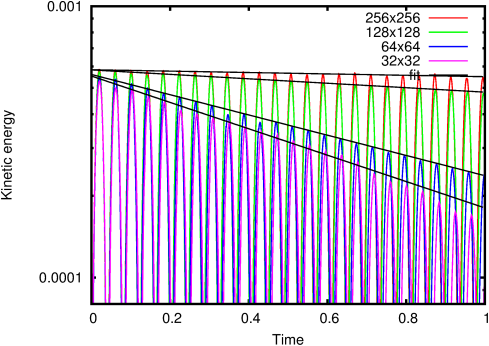


9.3 PASS:
Shape oscillation of an inviscid droplet
-
Author
- Stéphane Popinet
- Command
- sh oscillation.sh
- Version
- 1.2.0
- Required files
- oscillation.gfs (view) (download)
oscillation.sh fit.ref
- Running time
- 3 minutes 26 seconds
A two-dimensional elliptical droplet (density ratio 1/1000) is
released in a large domain. Under the effect of surface-tension the
shape of the droplet oscillates around its (circular) equilibrium
shape. The fluids inside and outside the droplet are inviscid so
ideally no damping of the oscillations should occur. As illustrated
on Figure 119 some damping occurs in the simulation due to
numerical dissipation.
This simulation is also a stringent test case of the accuracy of the
surface tension representation as no explicit viscosity can damp
eventual parasitic currents.
| Figure 119: Evolution of the kinetic energy as a function
of time for the spatial resolutions indicated in the legend. The
black lines are fitted decreasing exponential functions. |
The initial shape of the droplet is given by:
The oscillation frequency is then [43]:
A comparison between the theoretical and numerical values of the
frequency is given in Figure 120.
| Figure 120: Relative error in the oscillation
frequency as a function of resolution. |
The amount of numerical damping can be estimated by computing an
equivalent viscosity. With viscosity, kinetic energy is expected to
decrease as:
where C is a constant, ν the viscosity and D the droplet
diameter. Using curve fitting the damping coefficient b=Cν/D2
can be estimated (black curves on Figure 119). An
equivalent Laplace number can then be computed as:
The equivalent Laplace number depends on spatial resolution as
illustrated in Figure 121.
| Figure 121: Equivalent Laplace number estimated from the
numerical damping of kinetic energy. |










